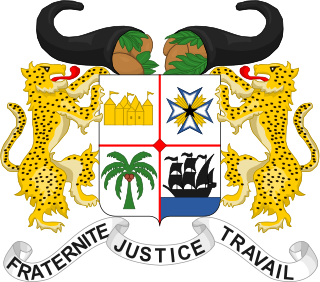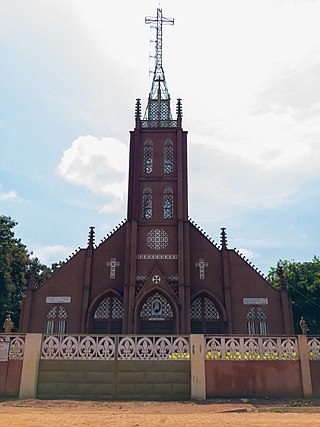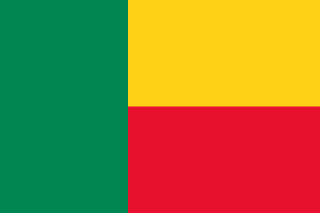Related Research Articles

Agbome or Abomey is the capital of the Zou Department of Benin. The commune of Abomey covers an area of 142 square kilometres and, as of 2012, had a population of 90,195 people.
Bohicon or Gbɔ̀xikɔn is a city in Benin, and a conurbation of Abomey lying 9 kilometres east of the city on the railway line from Cotonou to Parakou and on Benin's main highway RNIE 2 which joins the RNIE 4. The commune covers an area of 139 square kilometres and as of 2012 had a population of 149,271 people.

Zou is one of the twelve departments of Benin, named for the Zou River which travels through the department before emptying into the Atlantic in the south of the country. The department of Zou was split in two in 1999, with the northern territory transferred to the newly created Collines Department. The capital of Zou is Abomey. Zou is subdivided into nine communes, each centred at one of the principal towns: Abomey, Agbangnizoun, Bohicon, Cové, Djidja, Ouinhi, Za-Kpota, Zangnanado and Zogbodomey.

Abomey-Calavi is a city, arrondissement, and commune located in the Atlantique Department of Benin. It is now essentially a suburb of Cotonou and at its closest it begins approximately 18 km from the city centre of Cotonou. The main cities of the commune are Abomey-Calavi itself and Godomey to the south. The commune covers an area of 650 square kilometres and as at the May 2013 Census had a population of 655,965 people. Projected to be the eleventh fastest growing city on the African continent between 2020 and 2025, with a 5.27% growth.

Savalou is a city located in the Collines Department of Benin. The commune covers an area of 2,674 square kilometres and as of 2012 had a population of 35,433 people. It is the birthplace of Olympic Beninese hurdler Odile Ahouanwanou.

Stade de l'Amitie or Friendship Stadium is a multi-purpose stadium in Cotonou, Benin. It is currently used for football matches and also has facilities for athletics. The stadium has a capacity of 35,000 people.

The departments of Benin are subdivided into 77 communes, which in turn are divided into arrondissements and finally into villages or city districts. Prior to 1999 provinces were broken down into 84 districts, titled either urban or rural. Before independence, the six provinces were subdivided into Cercles, cantons, préfectures and villages or towns.

Stade Charles de Gaulle is a multi-use stadium in Porto-Novo, Benin named after Charles de Gaulle. It is currently used mostly for football matches and is used as the home stadium of AS Dragons FC de l'Ouémé, Aiglons FC. The stadium has a capacity of 15,000 people.

The Diocese of Abomey is a Catholic Latin Church diocese located in the city of Abomey in the ecclesiastical province of Cotonou in Benin.

The University of Abomey-Calavi(French: Université d'Abomey-Calavi) is the principal public university in the west African country of Benin. The university is located in the city of Abomey-Calavi in the south of the country.

Association football, or soccer, is the most popular sport in Benin. Governed by the Benin Football Federation, the Benin national football team joined both FIFA and CAF in 1969 as Dahomey. Dahomey became Benin in 1975.
This page details the process of qualifying for the 2002 African Cup of Nations.

The following outline is provided as an overview of and topical guide to Benin:
Agbangnizoun is a town, arrondissement, and commune in the Zou Department of south-western Benin. The town lies 20 kilometres south-east of Abomey. The commune covers an area of 244 square kilometres and as of 2002 had a population of 55,001 people.
Benin, officially the Republic of Benin, is a country in Western Africa. It borders Togo to the west, Nigeria to the east and Burkina Faso and Niger to the north; its short coastline to the south leads to the Bight of Benin. Its size is just over 110000 km2 with a population of almost 8500000. Its capital is the Yoruba founded city of Porto Novo, but the seat of government is the Fon city of Cotonou. About half the population live below the international poverty line of US$1.25 per day.
Golo-Djigbé is a town and arrondissement in the Atlantique Department of southern Benin. It is an administrative division under the jurisdiction of the commune of Abomey-Calavi. The population is 28,103 in 2013.

The Royal Palaces of Abomey are 12 palaces spread over an area of 40 hectares at the heart of the Abomey town in Benin, formerly the capital of the West African Kingdom of Dahomey. The Kingdom was founded in 1625 by the Fon people who developed it into a powerful military and commercial empire, which dominated trade with European slave traders on the Slave Coast until the late 19th century, to whom they sold their prisoners of war. At its peak the palaces could accommodate up to 8000 people. The King's palace included a two-story building known as the "cowrie house" or akuehue. Under the twelve kings who succeeded from 1625 to 1900, the kingdom established itself as one of the most powerful of the western coast of Africa.
Cyprien Tokoudagba was a Beninese sculptor and painter. He was from Abomey, Benin.

The 2006 CAF Champions League Final was a football tie held over two legs in December 2006. Al-Ahly of Egypt beat CS Sfaxien of Tunisia 2-1.
Kamel Djabour is a French football coach and former player.
References
- ↑ "Stadiums in Benin". worldstadiums.com. Archived from the original on 2012-01-08. Retrieved 2010-09-27.